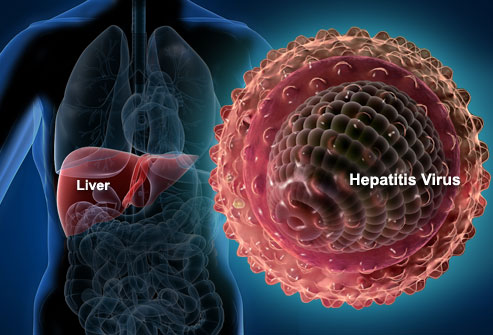Learn all about different types of viral hepatitis!
The term viral hepatitis is used to describe a group of diseases caused by separate types of virus and typically transmitted by different means.These are termed as as hepatitis type A, hepatitis type B, hepatitis type c, hepatitis type D and hepatitis type E.Hepatitis A, B and C are more common than other type of viral hepatitis out of which hepatitis B and C are vary fatal.Fortunately, hepatitis B vaccine is available which pretty good thing in the prevention of such lethal type of viral hepatitis but unfortunately hepatitis C vaccine is not available.Each type has different sign and symptoms except few like pale yellow skin, abdominal discomfort, mild fever and body pain.
1.Hepatitis A
This type of hepatitis is more common among children and young adults than in older persons. The virus is usually transmitted by person to person contact, especially among those living under crowded conditions with poor hygiene. The virus can be transmitted by contaminated food or water.The symptoms of the illness begin from between two and six weeks after the virus was transmitted to the individual. The onset of symptoms is usually abrupt, and the duration of the illness is about six to eight weeks shorter than the duration for hepatitis B. Hepatitis type A is seldom associated with serious complications, there being a mortality rate of only about 0.1 percent. Hepatitis type A can be prevented or at least modified by the administration of immune serum globulin even after contacts have been made with persons ill with the disease. The protection afforded by the use of immune serum globulin, lasts up to six months.
2.Hepatitis B
Hepatitis type B typically affects young adults, but it may affect older persons also, It seldom affects children. The virus for this type of hepatitis is usually transmitted by accidental injection by some contaminated instrument such as a hypodermic needle (as used in drug abuse), a tattooing needle, the instrument for piercing earlobes, or by blood transfusion.The incubation period is 45 to 160 days (average 120 days).Person who are at high risk to develop hepatitis B are Infants born to infected mothers, Sex partners of infected persons, Persons with multiple sex partners, Injectable drug users, Health care workers exposed to blood and Hemodialysis patients.
3.Hepatitis C
Hepatitis C virus (HCV) is transmitted by contact with blood of an infected person.The incubation period is 14 to 180 days (average: 45 days). HCV is basically a single stranded RNA virus having features similar to flaviviruses.About six major genotypes of HCV have been identified.People who are at high risk to get involve in hepatitis C are Current or former injectable drug users, recipients of blood transfusions, long-term hemodialysis patients, health care workers after needle sticks, HIV-infected persons, babies born to infected mothers and unprotected sexual intercourse with infected individual.Currently, there is no vaccine available for the prevention of hepatitis C.The best way of prevention of hepatitis B is vaccination because hepatitis B vaccine is available worldwide (Engerix-B).
4.Hepatitis D
Hepatitis D virus (HDV) is transmitted through percutaneous or mucosal contact with infectious blood. HDV is an incomplete virus that requires the helper function of HBV to replicate and only occurs in people infected with HBV. HDV is uncommon in the United States.persons who are at high risk to get involved in hepatitis D are Persons infected with HBV and Injectable drug users.Sign and symptoms of hepatitis D include Fever, fatigue, Nausea, vomiting, Abdominal pain, Jaundice and Joint pain. There is no vaccine available for the prevention of hepatitis D.
5.Hepatitis E
Hepatitis E virus (HEV) is spread by the fecal–oral route.HEV usually results in a self-limited or acute illness.HEV is uncommon in the United States.Signs and symptoms of hepatitis E include Fever, fatigue, Nausea, vomiting, Abdominal pain, Jaundice and Joint pain.Improved public hygiene can reduce the risk of HEV infection in endemic areas.Hepatitis E usually resolves on its own so, only supportive threapy is required e.g proper rest and fluids intake.Vaccine for hepatitis is under clinical trials and it has shown promising results in clinical trials.
 Health & Care Information
Health & Care Information 



as milion peopele on the world i am looking for new or alternative therapy for hep. c
best wishes forom serbia